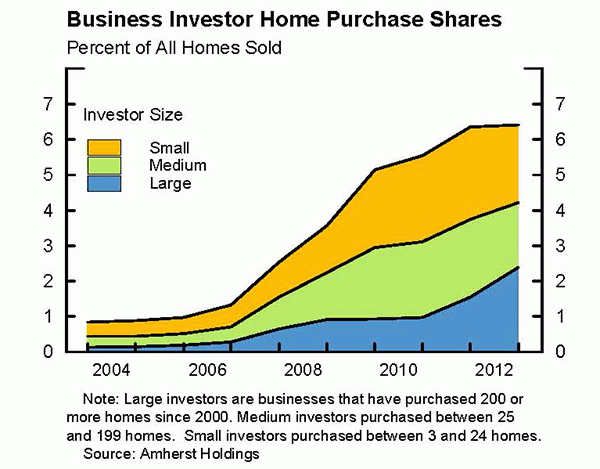The Housing Recovery Of 2013 May Be On Its Last Legs. Here's Why.


A remarkable U.S. housing recovery in 2013, where home prices rose about 12 percent, may have been driven mostly by business-oriented investors who bought cheap foreclosed homes and quickly flipped them for profit, according to real estate experts.
“Housing price gains were driven largely by investors who were buying property at “bottom of market” prices,” wrote Jeff Taylor, managing partner of major mortgage risk company Digital Risk, in an email to IBTimes.
But as the supply of foreclosed and lender-owned properties dwindled and prices spiked, investors began to exit their investments in the last quarter of 2014, leading to a slowdown in housing price growth toward the end of the year, he said.
“To maintain aggressive housing price growth in 2014 will require the return of the retail buyer, which is only marginally likely,” he continued. “Limited growth in income, higher interest rates and other factors will mitigate return of this type of buyer.”
The upshot: Housing prices are likely to appreciate substantially less in 2014, since business investors are hard to replace.
Next week the Mortgage Bankers Association will forecast that loan originations – including new home buying and mortgage refinancing – will hit its lowest level since 2000, according to the Wall Street Journal. That could hurt the revenues at big banks like Wells Fargo & Co. (NYSE:WFC), the country’s largest mortgage lender.
Standard & Poor’s Financial Services LLC, which produces the monthly benchmark Case-Shiller home price index, expects a 6 percent increase in home prices in 2014, or half the rate of 2013 advances. That compares with historical averages of 4 percent to 5 percent.
Part of the problem could be a recent rise in mortgage interest rates. S&P forecasts that the 30-year fixed-rate mortgage interest will rise to 4.6 percent in 2014, from 4.2 percent toward the end of 2013.
Mortgage rates have risen since May 2013, averaging 4.7 percent last week. Higher interest rates make mortgages more expensive to maintain, and discourage refinancing. The U.S. held $13.1 trillion in collective outstanding mortgage debt in late 2013, according to the Federal Reserve, down from $14.4 trillion in 2009.
In December, Fed economists said in a research paper that investors buying up single-family homes could both benefit and harm the real estate market.
“Business investor activity has likely aided the recovery in certain housing markets by helping to clear the inventory of vacant and foreclosed homes,” Fed economists Raven Molloy and Rebecca Zarutskie wrote on Dec. 5.
“Nonetheless, investor activity may pose risks to local housing markets if investors have difficulties managing such large stocks of rental properties or fail to adequately maintain their homes,” they continued. “If an investor suffers financial distress, it may be forced to sell a large number of homes at once or cut maintenance expenditures, which could lower house prices in the surrounding area.”
They concluded that since business investment portfolios were a small portion of overall home buying, they didn’t pose a significant risk to financial stability. But they’d be on the watch if investor portfolios expanded significantly, or if they used too much debt to buy homes.

For firms that lend to small-time real estate investors, often wealthy individuals or small companies, business has boomed.
Regional lender Lima One Capital, active in Georgia and the Carolinas, doubled its loans from 2012 to 2013, with a 180 percent uptick in loan values. It plans to expand to eight new states in 2014, as it predicts real estate business investment will continue to flourish.
Lima One's loans averaged $166,000 in December 2013, including a $1.2 million loan in Atlanta’s upscale Buckhead neighborhood.
“We anticipate the flipping market will increase,” Lima One Capital CEO John Warren told IBTimes. He agreed that flipping broadly drove up home prices.
In some poorer neighborhoods, major institutional investors, like the $248 billion Blackstone Group LP (NYSE:BX), have driven up prices, said Warren. Blackstone bought thousands of U.S. homes in 2013, often to rent out to tenants, and marketed a new type of real estate bond, backed by rental income, with Deutsche Bank AG (USA) (NYSE:DB) late in the year. The company is the largest owner of single-family homes in the U.S., with its real estate business worth at least $60 billion in assets managed.
“Bonds back[ed] by the underlying houses or rental income could become a medium through which house prices are bid up to unsustainable levels,” warned Fed economists in their December paper, in a footnote. They could also spur shadow banking if public markets developed a taste for these new types of bonds.
Tighter mortgage lending rules that came into effect Friday could also impact mortgage applications, reported Reuters. “Friction from new regulations will greatly reduce mortgage-origination volume,” wrote Taylor.
Some 9.3 million U.S. residential properties were still worth significantly less than their original values, according to a RealtyTrac report from Thursday. Almost half of homes in foreclosure were “deeply underwater,” meaning their home values plummeted. U.S. homeownership stands at about 64 percent.
Experts seem ambivalent on business investment and its potential importance or benefit to U.S. housing. “The lower-than-average homeownership rate and swarm of investor purchases might or might not be a long-term model for U.S. housing,” wrote S&P analyst Devi Aurora earlier this week.
© Copyright IBTimes 2024. All rights reserved.





















